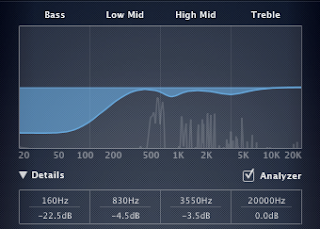This time I am going to give a some "hands on" practical use when playing with a piezo pickup. You will be able hear the difference for yourself in my sound clips and hopefully be on your way to better sounding gig and recordings.
I would like to start of by saying that you will most likely not be getting any "preset" EQ curves from this article. I am just trying to pass on advice, from some hard learned experience with recording, mixing and playing live on stage.
The bowed instruments - violin, viola and cello - have some auditive characteristics in common. In short; they where all made for cutting through, when played acoustically.
These characteristics are good to have in mind when trying to get the best sound in a recording studio or on stage with a PA system, because the frequencies that makes them cut through from a distance are often the frequencies you have to worry about when using an attached pickup as a magnifying glass close to the instrument amplifying a tiny portion of the instrument.
In Violin & viola EQ and frequencies part l I showed a graph of the violins spectrum, and I find it good to familiarize yourself with graphs like this in order to better be able to visualize the frequencies you could target when listening to your instrument.
One thing I have learned is that the violin when translating through a piezo pickup, in this case a bridge mounted piezo, attack and nasal frequencies often gets exaggerated and this again translates into harsh and hard sounds when played through PA.
In this part I have made a recording and put it through two types of EQ: A graphic 10 band EQ, which can often be found on the fiddlers pedal board. And a 4 band semi-prametric, which is often found on PA mixers (digital or larger ones).
First I listen to the recording a couple of time to identify the frequencies I would like to target.
I hear some bow thump, so a heavy cut of frequencies below 200hz is in order. (remember the violin goes down to 196hz and the viola to 130hz)
In the mids I hear some typical piezo nasality, which is often in the spectrum from 800-1200hz.
I also hear a some harshness and some bow noise, which is in 2000-3000hz and the 6000-8000hz areas.
How can you be sure where to target?
Well, after first listening and visualizing the sound I am going for, I start to boost the different frequencies to hear if the problems get worse.
Here is a clip where you can hear all the problem areas boosted.
First the graphic EQ:
 |
| graphic-eq boosting |
And then the semi-parametric:
 |
| semi-parametric boosting |
When I have confirmed my findings I will cut the problem frequencies. How much cut is needed is very dependent of the amp or PA system, but the general rule is to cut as little as possible and affect as few frequencies as possible. (remember that -3db is 50pct. of 0db)
 |
| graphic-eq cutting |
Here are the samples of the EQ curves engaged. Firstly the 10 band graphic EQ:
 |
| semi-parametric cutting |
Then a clip with the parametric EQ engaged:
These are realistic EQ curves, though maybe not to everyones taste.
The sound I was going for might sound a little dull, but in my experience most amp and PA's will make up for this and will, together with just a tad of reverb, ad some liveliness in a live setting.
In the recording studio the low and mid cuts can help bring the violin forward in the mix, if the violin plays a solo role. If there are more violins or a strings section the highs does not need to be cut.
go to part I

thanks
ReplyDeleteThank you, Kevin. Sorry for the missing sound samples - i am looking for a way to keep them on the blog..
DeleteGreat tips on your site. Is there any way to get the sound samples on this EQ frequency page?
ReplyDeleteThanks Eric. When I get some time on my hands I will try and Update on all the sound samples, which for some reason vanished..
ReplyDeleteTake the violin out of its case and leave the bow. What I would stress the most when having your violin is to hold it the correct way. violin tuner
ReplyDeleteI first picked up the violin in third grade (many years ago), and it helped spurred my endless love for all types of music ever since. violin teacher
ReplyDelete